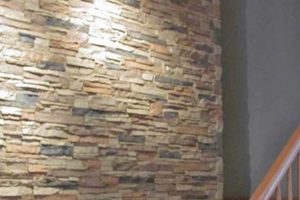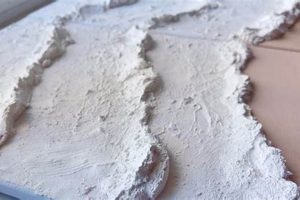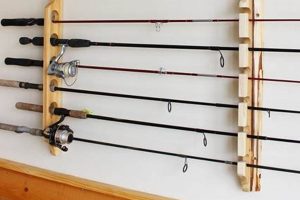Constructing a customized vertical play structure designed to promote physical activity and problem-solving skills in children represents a popular trend in home recreation. Such structures typically involve securely affixing handholds to a stable, inclined surface, allowing children to ascend and traverse. These play structures are often built using readily available materials and tools.
The advantages of such constructions extend beyond mere entertainment. These customized play areas foster gross motor skill development, enhance spatial reasoning, and encourage strategic thinking as children plan their routes. Furthermore, the act of creating such a structure can be a valuable family project, fostering collaboration and a sense of accomplishment. Historically, similar climbing apparatuses have been used in physical education and recreational settings for decades, demonstrating the enduring appeal of climbing as a beneficial activity.
Subsequent sections will detail considerations for safety, material selection, construction techniques, and design ideas for these customized play structures.
Construction Guidance
The following guidelines are intended to assist in the safe and effective creation of a child’s climbing structure within a domestic setting. Adherence to these recommendations is crucial for ensuring structural integrity and minimizing potential hazards.
Tip 1: Structural Foundation: Prioritize a robust supporting structure. Solid wood framing, adequately secured to existing walls or a freestanding frame, is essential for load-bearing capacity. Consult local building codes for relevant regulations regarding wall attachment.
Tip 2: Material Selection: Opt for durable, non-splintering wood for the climbing surface. Plywood, specifically designed for construction purposes, is a common choice. Ensure the material is appropriately treated to resist moisture and prevent degradation over time.
Tip 3: Hold Placement: Strategically position climbing holds to offer a variety of challenges and skill levels. Avoid clustering holds in a single area. Consider ergonomic principles to promote natural climbing movements and reduce the risk of strain.
Tip 4: Secure Fastening: Use appropriately sized and rated bolts and T-nuts to secure the climbing holds to the structure. Regularly inspect the fasteners for tightness and wear to prevent loosening or failure.
Tip 5: Safety Surfacing: Install a shock-absorbent surface beneath the climbing area. Rubber mulch, padded mats, or a thick layer of sand can mitigate the impact of falls. Ensure the surfacing extends adequately beyond the perimeter of the structure.
Tip 6: Height Considerations: Limit the overall height of the climbing structure to a safe and manageable level for the intended age group. Excessive height increases the risk of serious injury in the event of a fall.
Tip 7: Regular Inspection: Implement a routine inspection schedule to identify and address potential hazards. Check for loose holds, damaged surfaces, and any signs of structural weakness. Promptly address any issues discovered.
Consistent application of these guidelines will significantly enhance the safety and longevity of the climbing structure, contributing to a positive and secure recreational experience.
The subsequent sections will delve into specific design considerations and advanced construction techniques.
1. Safety First
Prioritizing safety is paramount when constructing a customized climbing structure for children. The inherent risks associated with vertical activity necessitate meticulous attention to design, material selection, and installation practices. Neglecting safety protocols can lead to injuries ranging from minor scrapes to severe fractures.
- Structural Integrity and Load Capacity
The climbing structure must be capable of supporting the weight of the intended users. The framing, wall attachments, and climbing surface must meet or exceed load-bearing requirements. Inadequate structural strength can result in collapse, leading to significant injuries. Example: Using under-sized lumber or insufficient wall anchors. Implications: Risk of structural failure during use.
- Secure Hold Attachment
Climbing holds must be securely fastened to the climbing surface to prevent detachment during use. The use of appropriate bolts, T-nuts, and tightening torque is crucial. Regularly inspect hold attachments for looseness or damage. Example: Holds pulling away from the surface. Implications: Potential for falls due to hold failure.
- Fall Zone Clearance and Surfacing
The area beneath and around the climbing structure must be free of obstructions and equipped with shock-absorbent surfacing. This reduces the impact force in the event of a fall. Adequate clearance ensures that children do not collide with objects during a fall. Example: Inadequate padding thickness. Implications: Reduced protection against impact injuries.
- Height Limitations
The height of the climbing structure must be appropriate for the age and abilities of the intended users. Excessive height increases the risk of serious injury in the event of a fall. Consider implementing maximum height restrictions and providing spotting assistance. Example: An 8-foot wall for a 4-year-old. Implications: Higher risk of severe injury from elevated falls.
The successful integration of these safety facets is essential for creating a recreational climbing surface that promotes physical activity while minimizing the risk of injury. Ongoing vigilance and proactive maintenance are necessary to maintain a safe climbing environment for children.
2. Structural Integrity
Structural integrity represents a foundational requirement for any customized climbing structure intended for children. This aspect directly dictates the safety and longevity of the apparatus, ensuring that it can withstand the dynamic loads imposed during use. Compromises in structural integrity introduce unacceptable risks of failure, potentially resulting in serious injury.
- Framing Material and Construction
The choice of framing material and the execution of its construction are paramount. Solid wood framing, employing appropriately sized lumber and secure joinery techniques, is essential for load-bearing capacity. The framing must resist bending, shearing, and compression forces generated during climbing. Examples include using pressure-treated lumber for outdoor applications and employing reinforced joints at critical stress points. Inadequate framing can lead to deformation or collapse under load.
- Wall Attachment Methods
For structures affixed to existing walls, the attachment method must effectively transfer the load from the climbing wall to the wall’s structural members. The use of appropriately rated anchors, spaced at intervals dictated by load calculations, is crucial. Concrete walls require different anchoring systems than wood-framed walls. Improper attachment can result in the wall pulling away from the supporting structure, leading to catastrophic failure.
- Climbing Surface Material
The climbing surface, typically constructed from plywood or a similar engineered wood product, must possess sufficient thickness and rigidity to resist bending and deflection between support points. The material must also be free of defects that could compromise its strength. Examples include using marine-grade plywood for increased moisture resistance and reinforcing the surface with additional layers of material. Insufficient surface thickness can result in cracking or delamination under load.
- Fastener Selection and Torque
The fasteners used to attach climbing holds to the surface must be of sufficient strength and properly torqued to prevent loosening or failure. The use of T-nuts and appropriately sized bolts is standard practice. Regularly inspect fasteners for tightness and replace any that show signs of corrosion or damage. Loose or corroded fasteners can result in holds pulling away from the surface, increasing the risk of falls.
These interconnected elements of structural integrity are indispensable for constructing a secure and durable climbing structure for children. A thorough understanding of load calculations, material properties, and construction techniques is essential for mitigating risks and ensuring a safe recreational experience. Furthermore, ongoing monitoring and maintenance are crucial for preserving structural integrity over time.
3. Hold Placement
Hold placement is a critical design element in the creation of a safe and engaging climbing structure. The strategic arrangement of handholds and footholds directly influences the difficulty, accessibility, and overall usability of the climbing surface, particularly for children.
- Difficulty Calibration
The spacing and orientation of holds determine the physical demands placed on the climber. Closer holds generally facilitate easier routes, while wider spacing increases the reach required, thereby raising the difficulty level. For children, a diverse range of hold placements is desirable, allowing for routes that accommodate varying skill levels and physical abilities. Example: Clustering holds for beginners versus widely spaced holds for more advanced climbers. Implications: Inappropriate difficulty can discourage participation or lead to unsafe climbing practices.
- Ergonomic Considerations
Hold placement should adhere to ergonomic principles to promote natural and comfortable climbing movements. The angle, size, and shape of holds should accommodate a variety of hand sizes and grip strengths. Poorly placed holds can lead to awkward body positions, increasing the risk of strain or injury. Example: Angling holds to encourage a natural wrist position. Implications: Improper ergonomics can result in discomfort, fatigue, or repetitive stress injuries.
- Accessibility and Reach
The height and position of holds must be accessible to the intended age group. Children have shorter reaches than adults, necessitating hold placements that are within their comfortable range of motion. Strategically placed holds can provide resting points or facilitate specific climbing techniques. Example: Ensuring the first few holds are easily reachable from the ground. Implications: Inaccessible holds can prevent successful completion of routes and diminish the enjoyment of the climbing experience.
- Route Design and Problem-Solving
Hold placement is integral to creating engaging and challenging climbing routes. The arrangement of holds can encourage climbers to develop problem-solving skills as they strategize their ascent. Varying hold types and placements can introduce new challenges and promote the development of different climbing techniques. Example: Creating a route that requires a traverse or a dyno (dynamic movement). Implications: Monotonous hold placements can lead to boredom and limit the development of climbing skills.
In conclusion, hold placement significantly impacts the overall functionality and enjoyment of a climbing structure designed for children. A well-designed hold configuration promotes physical activity, enhances problem-solving skills, and ensures a safe and rewarding climbing experience.
4. Material Selection
The selection of materials directly impacts the safety, durability, and overall cost-effectiveness of a customized climbing structure intended for children. Each component, from the structural frame to the climbing holds, necessitates careful consideration of material properties and suitability for the intended application.
- Structural Frame Material
The structural frame, which provides the primary support for the climbing wall, requires materials capable of withstanding significant loads and environmental factors. Solid wood (e.g., pressure-treated lumber for outdoor applications) or steel offer robust options. The choice depends on factors such as budget, desired aesthetic, and location of the wall (indoor vs. outdoor). Inadequate frame material can lead to structural failure and potential injury. Example: Using untreated softwood for an outdoor climbing wall. Implications: Accelerated decay and compromised structural integrity.
- Climbing Surface Material
The climbing surface, typically constructed from plywood or a similar engineered wood product, must be durable, splinter-resistant, and capable of securely accommodating climbing holds. Plywood thickness is a critical consideration, with thicker panels offering greater rigidity and load-bearing capacity. The surface should be sanded smooth to minimize the risk of splinters. Example: Using OSB (Oriented Strand Board) instead of plywood. Implications: Reduced strength, increased risk of splintering, and difficulty in securing climbing holds.
- Climbing Holds Material
Climbing holds are typically manufactured from durable plastics or resins designed to withstand repeated use and exposure to weather (for outdoor applications). The material must provide a secure grip and resist cracking or breaking under load. Different hold materials offer varying textures and levels of grip. Example: Using brittle plastic holds in a high-traffic area. Implications: Increased risk of hold breakage and potential injury.
- Fastener Material
Fasteners, including bolts, T-nuts, and screws, play a crucial role in securing the climbing surface to the frame and attaching climbing holds to the surface. The selected fasteners must be of sufficient strength and corrosion resistance to withstand the loads and environmental conditions. Stainless steel fasteners are often preferred for outdoor applications to prevent rust and degradation. Example: Using uncoated steel screws in a damp environment. Implications: Corrosion and weakening of the fasteners, leading to potential failure.
The careful selection of appropriate materials, tailored to the specific requirements of a climbing structure, is paramount for ensuring its safety, longevity, and overall value. Failure to adequately consider material properties can result in compromised structural integrity, increased maintenance costs, and a heightened risk of injury.
5. Age Appropriateness
The concept of age appropriateness is fundamentally intertwined with the design and construction of a customized climbing structure for children. The physical and cognitive capabilities of children vary significantly across developmental stages, necessitating a design that aligns with their abilities and limitations. Failure to adequately consider age appropriateness introduces inherent risks, diminishing the recreational and developmental benefits of the activity.
Cause and effect are readily apparent: a climbing wall designed for older children, featuring excessively spaced holds or a steep incline, will prove challenging or even dangerous for younger children. The lack of accessibility and increased risk of falls can discourage participation and potentially lead to injuries. For example, a pre-schooler attempting a climbing route designed for a grade-schooler is at a significantly higher risk of falling and sustaining an injury. Therefore, the size and spacing of the holds, the overall height of the structure, and the complexity of the climbing routes must be carefully calibrated to match the age and developmental stage of the intended user. The importance of age-appropriate design cannot be overstated: it ensures both safety and a positive climbing experience.
The practical significance of this understanding manifests in several key design considerations. Firstly, the height of the wall should be limited to a manageable level for the age group, reducing the potential for severe falls. Secondly, hold placement should prioritize accessibility and ergonomic comfort for smaller hands and shorter reaches. Thirdly, the inclusion of varying routes with graded difficulty allows for progressive skill development. Finally, fall protection measures, such as adequate padding thickness and appropriate supervision, are essential. Addressing these concerns ensures a secure and developmentally appropriate climbing environment, fostering physical activity and cognitive development while minimizing the risk of harm. The integration of these considerations results in a recreational structure which maximizes developmental benefits and ensures user safety.
6. Fall Protection
The implementation of effective fall protection measures is non-negotiable in the construction of customized climbing structures intended for use by children. The inherent risks associated with elevated activity necessitate proactive strategies to mitigate the potential for injury resulting from falls. Adequate fall protection significantly reduces the severity of impact, minimizing the likelihood of serious harm.
- Impact-Absorbing Surfaces
The provision of impact-absorbing surfacing beneath and around the climbing structure is a primary means of mitigating fall-related injuries. Materials such as rubber mulch, padded mats, or a thick layer of sand can effectively cushion falls, reducing the force of impact. The depth and composition of the surfacing material should be carefully selected based on the anticipated fall height and the weight of the users. For instance, a climbing wall with a fall height of 6 feet necessitates a thicker layer of impact-absorbing material than one with a 4-foot fall height. Inadequate surfacing provides insufficient protection, increasing the risk of fractures and head injuries.
- Fall Zone Clearance
Maintaining a clear fall zone around the climbing structure is crucial for preventing collisions with surrounding objects during a fall. The fall zone should be free of obstructions such as furniture, sharp objects, and other potential hazards. The extent of the fall zone should be commensurate with the height of the climbing wall, ensuring that there is sufficient space for a safe landing. Example: Designating a perimeter extending at least 6 feet beyond the base of the climbing wall. Inadequate clearance can exacerbate injuries by increasing the likelihood of impact with stationary objects.
- Supervision and Spotting
Active supervision and spotting by a responsible adult can significantly reduce the risk of falls and provide assistance to children who are struggling or at risk of falling. Spotters can help guide children to a safe landing or provide physical support to prevent a fall. Supervision also allows for the prompt identification and correction of unsafe climbing practices. Example: A spotter positioning themselves behind a climber to provide support and guidance. Lack of supervision increases the likelihood of unsupervised risky behavior and delayed intervention in the event of a fall.
- Harnesses and Ropes (Advanced Applications)
In more advanced applications, particularly for taller climbing walls or those designed for older children, the use of harnesses and ropes may be considered. Harnesses provide a secure attachment point for a rope, which can be used to belay the climber, preventing them from falling to the ground. The use of harnesses and ropes requires specialized training and equipment and should only be implemented under the supervision of a qualified instructor. Example: Using a top-rope belay system to secure a climber on a high climbing wall. Improper use of harnesses and ropes can create a false sense of security and potentially increase the risk of injury.
In conclusion, a comprehensive fall protection strategy, incorporating impact-absorbing surfaces, clear fall zones, active supervision, and (where appropriate) harnesses and ropes, is essential for creating a safe and enjoyable climbing experience for children. Proactive implementation of these measures minimizes the risk of fall-related injuries and maximizes the recreational and developmental benefits of the activity. Consistent monitoring and maintenance of fall protection equipment are also crucial for ensuring its continued effectiveness.
7. Maintenance Schedule
The implementation of a rigorous maintenance schedule is fundamentally linked to the sustained safety and functionality of a customized climbing structure intended for children. The absence of such a schedule introduces an elevated risk of component failure, potentially leading to injury. A well-defined maintenance protocol functions as a proactive measure, identifying and rectifying potential hazards before they escalate into critical safety concerns. Real-world examples abound: unchecked loosening of climbing holds, gradual degradation of impact-absorbing surfaces, and undetected structural weaknesses all exemplify the consequences of neglected maintenance. The practical significance of this understanding lies in the preventative nature of scheduled inspections and repairs.
Detailed examples of necessary maintenance tasks include regular torque checks on all climbing hold fasteners, ensuring they remain securely attached to the climbing surface. The climbing surface itself requires periodic inspection for signs of wear, splintering, or cracking, necessitating repair or replacement as needed. Impact-absorbing surfaces warrant assessment for compaction, displacement, or degradation, ensuring continued effectiveness in mitigating fall impacts. The structural frame, too, demands scrutiny for signs of rust, rot, or loosening of connecting hardware. Lubrication of moving parts, such as hinges or adjustment mechanisms, is also critical where applicable. Documentation of these tasks, including dates, findings, and corrective actions, provides a valuable record for future reference.
In summary, the maintenance schedule is not merely an ancillary element but an integral component of a “diy climbing wall for kids,” essential for preserving structural integrity, mitigating safety risks, and maximizing the lifespan of the structure. Consistent adherence to a comprehensive maintenance plan ensures a safe and enjoyable recreational environment for children. A potential challenge involves educating caregivers on the importance of maintenance and providing them with the resources and training necessary to effectively execute the maintenance schedule. This aligns with the broader theme of promoting safe and developmentally appropriate play environments for children.
Frequently Asked Questions
The following addresses common inquiries regarding the design, construction, and maintenance of customized climbing structures intended for use by children.
Question 1: What are the fundamental safety considerations when constructing a climbing structure for children?
Prioritizing structural integrity, secure hold attachment, appropriate fall zone surfacing, and adherence to age-appropriate height limitations are paramount. Regular inspection and maintenance protocols must also be implemented.
Question 2: How is appropriate structural integrity ensured in a DIY climbing wall?
Employing robust framing materials, secure wall attachment methods, durable climbing surface materials, and appropriately rated fasteners is critical. Adherence to load-bearing requirements and regular inspection for signs of weakening is essential.
Question 3: What is the recommended approach to hold placement for a climbing structure designed for children?
Hold placement should prioritize accessibility, ergonomic comfort, and age-appropriate difficulty. A variety of hold types and spacing can promote skill development and engagement. Avoid clustering holds in a single area.
Question 4: Which materials are deemed most suitable for constructing a child’s climbing structure?
Durable plastics or resins are typically used for climbing holds, plywood or similar engineered wood products for the climbing surface, and solid wood or steel for the structural frame. Selection depends on factors such as budget, desired aesthetic, and location of the wall.
Question 5: What defines “age-appropriateness” in the context of a DIY climbing structure?
Age-appropriateness refers to the alignment of the structure’s design with the physical and cognitive capabilities of the intended users. This includes limiting the height, adjusting hold spacing, and providing a variety of routes to accommodate different skill levels.
Question 6: What fall protection measures should be incorporated into a customized climbing structure?
Impact-absorbing surfaces such as rubber mulch or padded mats, a clear fall zone free of obstructions, and active supervision by a responsible adult are essential. In some cases, harnesses and ropes may be considered, but require specialized training.
The considerations outlined above represent fundamental aspects of constructing a safe and functional climbing structure for children.
Subsequent sections will address advanced design and construction techniques for DIY climbing walls.
Conclusion
The preceding sections have detailed the multifaceted considerations involved in creating a “diy climbing wall for kids.” From structural integrity and material selection to hold placement, age appropriateness, and stringent safety protocols, the successful realization of such a project demands careful planning and execution. The exploration encompassed essential construction techniques, maintenance schedules, and potential hazards, emphasizing the responsibility inherent in providing a safe and stimulating recreational environment.
The information outlined serves as a foundation for informed decision-making. Prospective builders should meticulously review local building codes, consult with qualified professionals when necessary, and prioritize safety above all else. The creation of a “diy climbing wall for kids” represents a significant undertaking with the potential to enhance physical development and cognitive skills, but only when approached with diligence and a commitment to safety standards.







